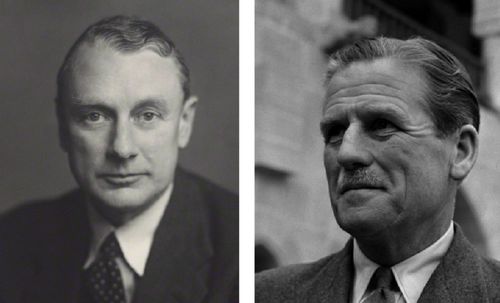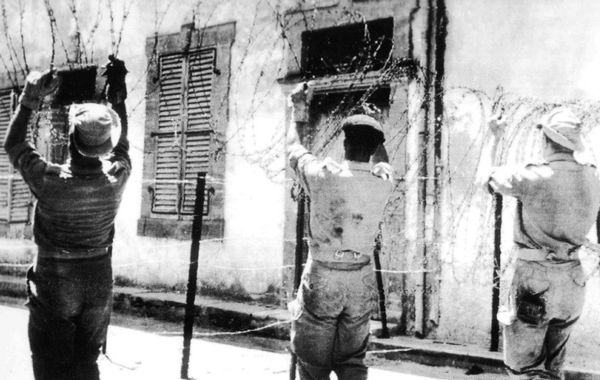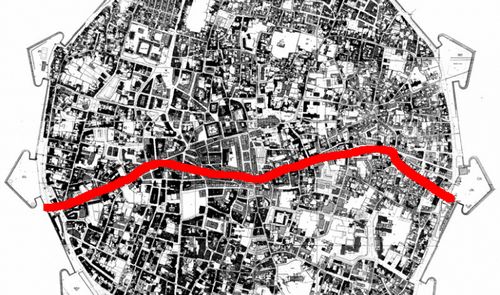The First Demarcation Line
The EOKA military campaign against the British officially began on the 1st April 1955 and, from the start, Greek Cypriot policemen began resigning from the force. Those remaining were compelled to work longer hours for no additional pay.
Since Greek Cypriots were refusing to join the police, almost all new recruitment into the regular police came from the Turkish community. As still more men were needed, the Governor (Sir Robert Perceval Armitage) authorised a force of Auxiliary Police to be raised from within the Turkish Cypriot community.......they received little if any training and were inadequately led.
The Governor was fired in September 1955 and replaced by Sir John Harding. He expanded the Auxiliary Police although colonial officials had warned him that over-reliance upon a Turkish police force would alarm the Greek Cypriot population and would probably lead to open conflict between the two communities.

Cyprus Governors.......Sir Robert Perceval Armitage and Sir John Harding
"If Harding carefully had planned to alienate the entire Greek population of the island and push the moderate Greeks into full support of EOKA, he could not have done better than by his policy of unleashing a horde of untrained, poorly-led Turkish police on the population. Communal violence, rare in Cyprus before the insurgency, flared up in 1956 and increased throughout the insurgency. When the Turks rose against the Greeks, usually in response to an EOKA killing of a Turkish policeman, the all-Turkish Special Mobile Reserve and Auxiliary Police routinely stood by as Turkish mobs assaulted Greek civilians and ransacked their property."
Training Indigenous Forces in Counterinsurgency: A Tale of Two Insurgencies by James S. Corum published in March 2006
Martin Clemens was a British colonial administrator who served in Cyprus between 1948–1949 and returned to Cyprus in 1951–1957 as the Nicosia District Commissioner.
In May 1956, a number of Turkish Cypriot policemen were killed by EOKA members and this provoked some intercommunal violence.
Faced with this violence between the two communities, District Commissioner Clemens authorised a mile-long barrier splitting the Turkish Cypriot northern sector of Nicosia from the southern Greek Cypriot sector.
The details below are from "Mayhem in the Med.........a Chronicle of the Cyprus Emergency 1955-1960" by Richard Stiles.
(Written in the style of daily newspaper reports)
Tuesday 29th May, 1956:
Leaders Meet District Commissioner in Nicosia
Mr Martin Clements, the Nicosia District Commissioner, has agreed with leaders from both sectarian communities that in order to help curb the ongoing inter communal violence a six foot high barrier should be erected between the Greek and Turkish Quarters. Royal Engineers are to construct the barbed wire fence that will extend from the Paphos Gate to the Famagusta Gate. Armed sentries will control five access points, thus enabling law-abiding citizens, to go about their daily affairs. (Editorial: This obstacle was later nicknamed the 'Mason Dixon' Line). The Commissioner has also suggested that the Turkish community agree to pay compensation to the Greek Cypriot community following the high level of property damage inflicted in the Greek Quarter by Turkish Cypriot residents protesting against the recent killing of PC Ahmed.

British troops erect barbed wire barricades across a street in the heart of Nicosia on May 30, 1956, to form what was known then as the "Clemens Line".
Between Paphos and Famagusta Gates, the wire followed (from west to east)...........Paphos Street, Hermes Street and Famagusta Street.

The Clemens Line became the first instance of physical partition on the island and had defined the route of the future "Green Line".
As the level of tension changed, sections of wire were removed and then replaced until the barrier was completely removed at the end of the EOKA campaign.
Author's note: In later years the demarcation line did not follow Famagusta Street (RHS) but took a more northerly turn.